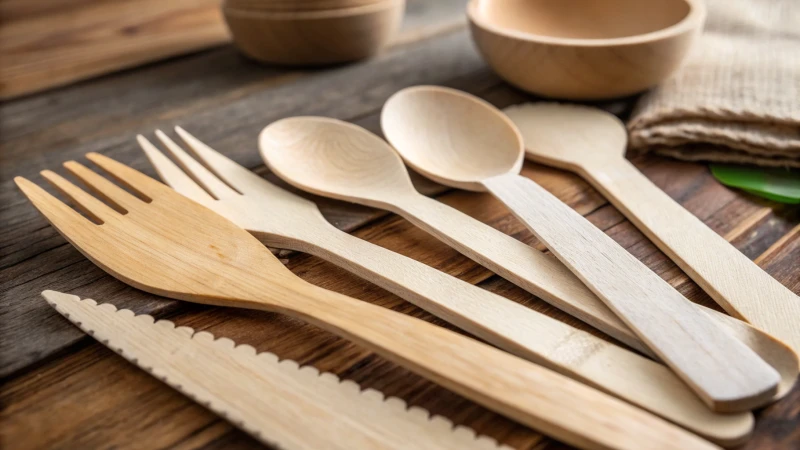
Ever wondered how to pick wooden cutlery that’s not just eco-friendly, but also smooth and safe?
To ensure disposable wooden cutlery is burr-free and smooth, manufacturers use ultra-precision laser cutting and high-frequency vibrating blades. These methods minimize imperfections, providing a safer and more pleasant dining experience.
It might sound technical, but knowing these methods helps me choose the best wooden cutlery for my needs. Imagine hosting a dinner party, feeling confident that each piece is crafted to perfection. Let's dive deeper into how these techniques contribute to quality and sustainability.
Ultra-precision laser cutting ensures burr-free cutlery.True
Laser cutting provides a clean edge, minimizing imperfections.
High-frequency vibrating blades increase stress in cutlery.False
These blades reduce stress concentration, enhancing smoothness.
How is burr-free wooden cutlery made?
Ever wondered how your wooden fork becomes so smooth and burr-free? Let me take you behind the scenes of the fascinating manufacturing process.
To create burr-free wooden cutlery, manufacturers rely on precision cutting, triple polishing, and nano-coating. These techniques ensure a flawless finish and high-quality cutlery.
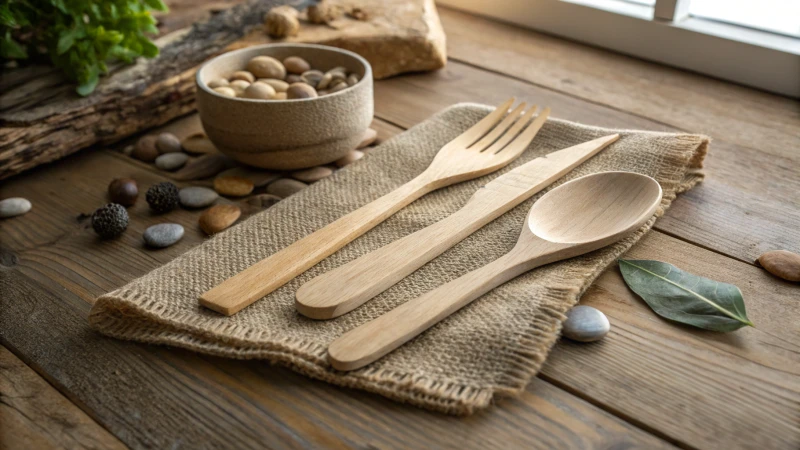
Precision Cutting Techniques
When I first got into the world of sustainable cutlery, I was amazed by the precision involved in the process. Precision cutting is a game-changer in making sure those annoying burrs are a thing of the past. Imagine lasers slicing through wood with the finesse of a surgeon's scalpel! Ultra-precision laser cutting1 is like that—it’s about reducing stress on the wood for a super clean cut.
Then there’s high-frequency vibrating blades. They sound like something out of a sci-fi movie, but they’re real and they work wonders. The speed they move at keeps cracks to an absolute minimum, ensuring the wood maintains its strength and beauty.
Advanced Polishing Methods
Once the cutlery is shaped, it’s time for some serious pampering. Triple polishing might sound fancy, but it’s essential. Think of it like getting a spa treatment: coarse polishing is like an exfoliation, fine polishing is the relaxing massage, and ultra-fine is that final facial mask that leaves your skin glowing.
| Polishing Stage | Purpose |
|---|---|
| Coarse | Like an exfoliation |
| Fine | The relaxing massage |
| Ultra-Fine | Final facial mask for glowing finish |
| Nano-Coating | Fills micro-crevices for flawless finish |
This is followed by nano-coating technologies2, which fill in even the tiniest imperfections for a flawless finish.
Quality Assurance with Machine Vision
And let's not forget about quality assurance—it's like having an eagle-eyed friend who never misses a detail. Machine vision systems do just that, catching any tiny defects with incredible accuracy, ensuring only the best cutlery makes it out of the factory.
I remember seeing this technology in action for the first time and thinking about how it felt like having a superhero on our side—working tirelessly to ensure every piece meets the highest standards. It’s these advanced quality control measures3 that make sure we deliver nothing but top-notch products every single time.
Ultra-precision laser cutting reduces wood stress.True
This method uses lasers to achieve clean cuts, minimizing burrs.
Nano-coating increases surface roughness of cutlery.False
Nano-coatings fill crevices, reducing surface roughness for smoothness.
How does triple polishing enhance wooden cutlery smoothness?
There's something truly magical about holding a piece of finely polished wooden cutlery. It transforms an ordinary meal into an exquisite experience. But what exactly makes these utensils feel so luxurious?
Triple polishing enhances wooden cutlery smoothness by methodically progressing through three stages: coarse, fine, and ultra-fine polishing. This precise approach ensures a near-flawless surface, achieving an impressive smoothness level of Ra 0.02 μm, significantly improving both the utensil's look and touch.
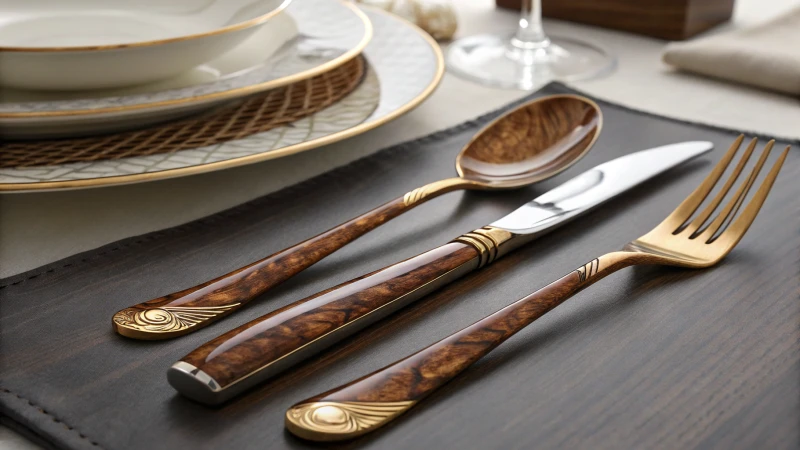
The Three Stages of Triple Polishing
I remember the first time I held a triple-polished wooden spoon. It was like a revelation—so smooth, it almost slipped through my fingers. This process starts with coarse polishing, where major imperfections are buffed away. Imagine leveling a bumpy road before paving it; that’s what this stage does for the wood.
Next comes fine polishing. This step reminds me of sanding down a wooden deck—taking it from rough to remarkably smooth, removing those little scratches you didn’t even know were there.
Finally, we reach ultra-fine polishing. Here, the wood is polished to a shine so fine that it's like looking at a reflection in still water. When I run my fingers over such cutlery, it’s hard not to marvel at the craftsmanship.
| Stage | Purpose | Outcome |
|---|---|---|
| Coarse Polishing | Remove major imperfections | Initial smoothing |
| Fine Polishing | Refine texture | Reduced scratches |
| Ultra-Fine Polishing | Achieve mirror-like sheen | Highest smoothness achievable |
Benefits of Enhanced Smoothness
The benefits? Oh, they're numerous. A smoother surface isn't just for show—it enhances the dining experience by reducing friction and increasing comfort. Think of it as slipping on a pair of silk gloves; everything just feels better.
Moreover, maintaining these utensils is a breeze. Their slick surfaces resist food residue, keeping them cleaner and more hygienic, which is crucial for places like healthcare environments4 where cleanliness is non-negotiable.
Combining Techniques for Maximum Effect
After perfecting the polish, adding a nano-coating5 can extend the cutlery's life by warding off moisture and stains. It’s like adding an invisible shield to your favorite shoes, keeping them pristine.
And here's the kicker—machine vision systems with 99.8% accuracy ensure every piece is flawless before it reaches you, just like having an eagle-eyed inspector checking each detail.
These techniques ensure that each piece of cutlery isn't just a tool but a testament to craftsmanship and sustainability—perfect for those who appreciate elegance in everyday items. Embracing such advancements means you’re not only choosing quality but also championing eco-friendly practices.
Triple polishing achieves a surface roughness of Ra 0.02 μm.True
Triple polishing refines the cutlery to a near-perfect finish with Ra 0.02 μm.
Nano-coating is applied before triple polishing for best results.False
Nano-coating is applied post-polishing to enhance durability and resistance.
Why is machine vision vital for quality assurance in wooden cutlery?
Imagine a world where every piece of wooden cutlery is crafted with flawless precision, thanks to cutting-edge technology that sees what human eyes can't.
Machine vision is essential for ensuring the quality of wooden cutlery because it automates the detection of defects, ensuring consistent high standards. By using cameras and software to spot flaws like cracks or surface irregularities, it significantly enhances overall product quality.
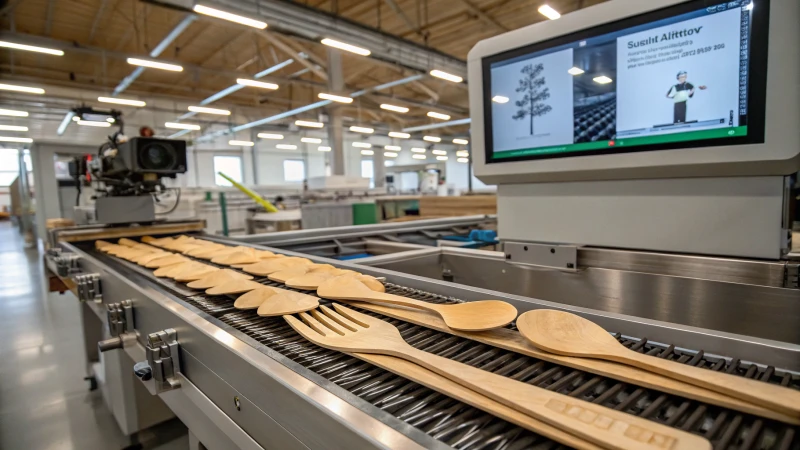
Enhancing Detection Accuracy
Machine vision systems in wooden cutlery production rely on high-resolution cameras and advanced algorithms to identify imperfections. These systems scan each piece, detecting micro-defects that would likely go unnoticed by human inspectors.
This capability is critical when aiming for the high-quality standards required by many eco-conscious buyers like Michael6, who prioritize sustainability without compromising on quality.
Speed and Efficiency in Production
One of the standout benefits of machine vision is its ability to operate continuously and efficiently, surpassing human capabilities. This is particularly vital for large-scale operations where consistency and speed are paramount.
For instance, Sarah7 in the food industry can rely on these systems to maintain consistent product quality while meeting large order demands without delays.
Ensuring Consistency Across Batches
Consistency is key in manufacturing processes, especially in industries where brand image and customer satisfaction are on the line. Machine vision ensures that each batch of wooden cutlery maintains the same high standards, essential for businesses like Emily8 who focus on brand consistency and premium quality.
| Feature | Benefit |
|---|---|
| High-resolution cameras | Detailed inspection of each item |
| Advanced algorithms | Precise detection of micro-defects |
| Continuous operation | Increased efficiency and productivity |
| Automated reporting | Real-time quality control data |
Integrating with Advanced Manufacturing Techniques
Machine vision systems complement other advanced manufacturing techniques, such as ultra-precision laser cutting and triple polishing. These combined technologies enhance the overall product by minimizing defects and ensuring a flawless finish.
As Dr. Lucas9 from the healthcare sector would appreciate, this integration ensures that products meet strict compliance standards while maintaining aesthetic appeal.
Cost-Effectiveness Through Automation
Although initial setup costs for machine vision systems can be significant, their ability to reduce waste and improve quality results in long-term savings. For businesses like Lisa10, who manage eco-friendly products online, these savings can be passed down to consumers, making sustainable options more accessible.
Machine vision detects micro-defects in wooden cutlery.True
Machine vision systems use high-resolution cameras to identify tiny imperfections.
Human inspectors are faster than machine vision systems.False
Machine vision operates continuously, surpassing human speed and efficiency.
Why Should We Choose Wooden Over Plastic Cutlery?
Remember the last time you tossed a plastic fork into the trash? I did too, until I discovered wooden cutlery and its positive impact on our planet.
Wooden cutlery shines over plastic due to its biodegradability, sustainable sourcing, and reduced carbon emissions. These attributes make it an eco-friendly choice, reducing pollution and supporting ecological health.
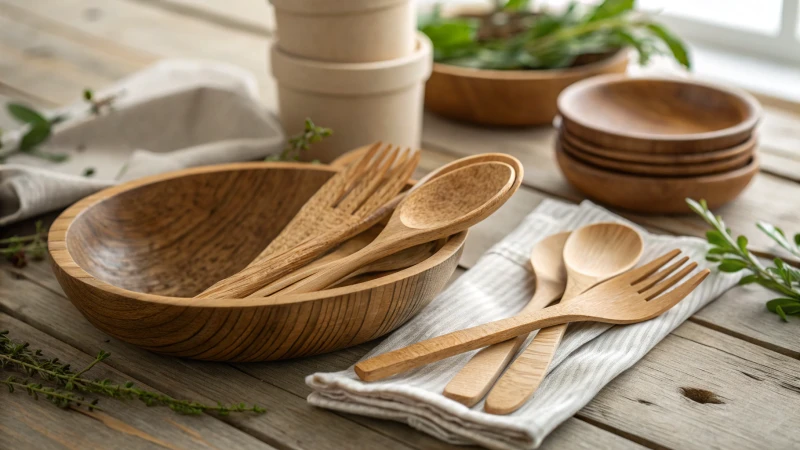
Biodegradability and Decomposition Rates
I still remember the day I learned how long a single plastic fork sticks around—up to 450 years! Compare that with wooden cutlery, which breaks down in just 3 to 6 months. It was eye-opening. Imagine tossing your wooden spoon into the compost and knowing it’ll soon nourish the earth rather than pollute it. That’s a huge win for reducing landfill waste and ocean pollution.
Consider this comparison:
| Material | Decomposition Time |
|---|---|
| Plastic | 450+ years |
| Wood | 3-6 months |
Wooden cutlery can also be composted, turning waste into valuable nutrients for the soil. This process supports a circular economy model, where resources are reused rather than discarded.
Sustainable Sourcing
Wooden cutlery is often sourced from sustainably managed forests11, and that’s a game changer. I’ve always been someone who loves nature—birds singing, trees swaying in the wind—so knowing my choice supports responsible forestry practices is a relief. It’s like casting a vote for biodiversity and healthy wildlife habitats every time I opt for wood over plastic.
Reduced Carbon Footprint
Let’s talk carbon footprints. Making wooden cutlery generally uses less energy and emits fewer carbon emissions than plastic. Plus, trees soak up CO2 as they grow. So, before that tree becomes my dinner fork, it’s already doing some good for our atmosphere. Switching to wooden utensils feels like doing my bit to combat climate change.
Economic Impact and Consumer Demand
There’s something really satisfying about supporting businesses that are committed to green values. When I see companies choosing eco-friendly products12, I know they’re aligning with what consumers want: a sustainable future. It’s exciting to watch businesses thrive by doing good.
Table: Consumer Preferences
| Attribute | Consumer Preference (%) |
|---|---|
| Eco-Friendly | 78% |
| Biodegradable | 65% |
| Sustainable Sourcing | 70% |
Challenges and Considerations
Of course, wooden cutlery isn’t perfect. It can be pricier than plastic and not always as durable. But when I think about the long-term environmental benefits—less waste, fewer emissions—I see it as an investment in our planet’s future. For businesses, prioritizing quality wooden cutlery can boost customer satisfaction and foster loyalty. In the end, making informed choices about sustainability, whether personally or professionally, is empowering.
Wooden cutlery decomposes faster than plastic.True
Wooden cutlery decomposes in 3-6 months, while plastic takes 450+ years.
Plastic cutlery is sourced from sustainably managed forests.False
Plastic is derived from petroleum, not forests, unlike sustainably sourced wood.
Conclusion
Manufacturers ensure disposable wooden cutlery is burr-free and smooth through ultra-precision laser cutting, triple polishing, and machine vision systems for quality assurance, enhancing both aesthetics and sustainability.
-
Learn how ultra-precision laser cutting improves cutlery quality by reducing burrs and maintaining material integrity. ↩
-
Explore how nano-coating enhances the smoothness and durability of wooden utensils. ↩
-
Understand how machine vision ensures top quality by detecting defects during production. ↩
-
Explore why smooth surfaces are vital in healthcare environments for maintaining high hygiene standards. ↩
-
Uncover how nano-coating can enhance wood's durability and resistance against environmental factors. ↩
-
Discover how machine vision enhances quality control, ensuring products meet rigorous standards efficiently. ↩
-
Learn how machine vision boosts efficiency and consistency in large-scale manufacturing. ↩
-
Explore why maintaining product consistency is crucial for brand reputation and customer satisfaction. ↩
-
Find out how combining machine vision with laser cutting enhances product precision and quality. ↩
-
Understand the long-term cost advantages of using machine vision for quality assurance. ↩
-
Learn how sustainably managed forests protect biodiversity and promote ecological balance. ↩
-
Explore why consumer interest in eco-friendly products is rising and how it influences business decisions. ↩

